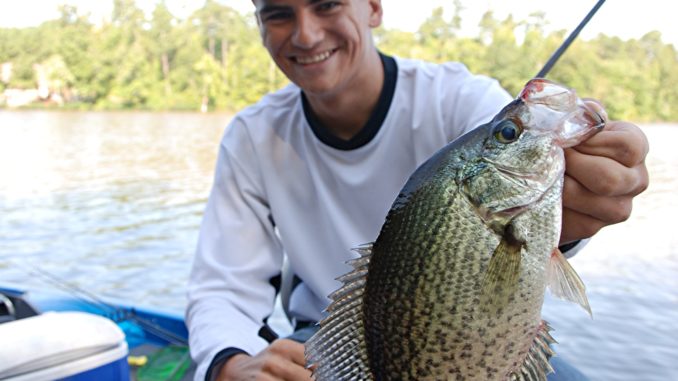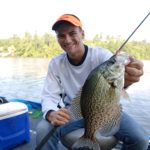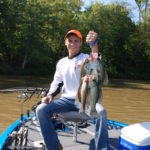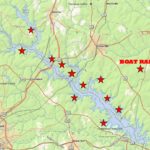
Lake Greenwood slabs are on the way to the backs of creeks this month; follow them and fill that limit using these expert tips.
Most teens strive to find their niche in high school. Some are athletes, others student government types, others bookworms, socialites or not-so-socialites. These days, it’s not uncommon for high schools to field their own bass-fishing club teams. Even so, Braxton Wall, a 17-year-old senior at Ninety Six High School near Lake Greenwood, is a crappie guy.
“I’ve been fishing crappie tournaments with my dad since I was in the fifth grade, and I’m a senior now,” he said. “I especially love fishing right here on Lake Greenwood; it’s a great lake. In 2012, we won the Southern Crappie tournament trail’s, South Carolina state championship — a 2-day tournament here on Lake Greenwood — and we won it by half a pound.”
“In the last couple of years, Ninety Six High picked up a bass-fishing trail,” he said. “I’ve got a friend of mine at school; he’s in his boat on Greenwood just about every day after school. He’s always on a bass pattern, and he’s dominated the high school tournament trail. Around school, he’s the bass guy, and I’m the crappie guy.”
Fall semester is one of Wall’s favorite times to fish Lake Greenwood. By late September, crappie are moving out of their deep-water summer patterns, chasing baitfish in the backs of creeks, storing fat that eventually will see them through the colder weather. There’s also plenty of daylight after school to hook up the boat, hit the water and limit out on big slab crappie before dark.
“You can expect to find fish headed toward the backs of creeks, holding anywhere from 5 to10 feet of water,” he said. “The fish are going to be mainly on the flats, running baitfish. The water temperature should be somewhere in the mid- to lower 70s. That’s about the time they get real active, when the bite turns on in the fall.”
While Braxton and his father, Rod Wall, are both particularly fond of long-line trolling, the most-productive fall tactic is to tight-line troll out on the flats where he has located schools of baitfish.
Like most teens, Wall has no fear of changing technology and embraces any upgrades in sonar and marine electronics like a kid with a new video game. In fact, Wall said he loves the latest advances in side-imaging sonar because it allows him to literally see individual fish before he starts rolling out long rods to catch them.
“Dad bought a Humminbird 997 unit for our tournament boat when the units first came out, and we’ve had side-imaging units ever since,” said Wall. “We’ve even sent in recorded data that has helped Humminbird adapt the software to make it better suited for the crappie fisherman. I’ve been using this technology and watching it grow up as I’ve grown up. It’s essential to my way of fishing; there’s no other way to put it.”
Wall said crappie tend to roam in the fall more than any other time of year, migrating with schools of baitfish. To catch them, he does not specifically target brush piles or other structure. He’s following nothing but his underwater eyes.
“Greenwood crappie aren’t going to be centralized on structure in the fall, so you’re going to have to have a good idea of the area and the depth of that water you saw the majority of the fish in and kind of build a mental pattern as you motor around the flats watching the graph,” he said. “Then, when you get set, you keep that pattern in mind and follow your electronics to stay on top of the fish.”
Wall’s typical set up is an eight-rod affair — the same number he and his father use in the majority of the tournaments they fish. He may only use four to six rods if he’s fishing by himself, or he will use the full contingent of eight if he’s got a buddy along for the afternoon.
“There’s no rod limit on Lake Greenwood,” he said. “It’s really what you limit yourself to and what the fish will limit you to. Often in the fall, we can only handle four rods between two people; the bite will be so fast that’s all you can handle. Other times, it’s slower. Usually, we’ll fish eight poles unless the bite gets out of hand, then we’ll bump back to six just so it doesn’t stress us out trying to keep up.”
Both Rod and Braxton Wall are B ’n’ M pro-staff members and have their pick of crappie rods. A typical tight-line setup is 14-foot graphite jig poles, equally distributed in rod holders around the bow. A remote-controlled trolling motor allows Wall to bump around or hold his boat in place if the baits are right in the faces of the fish. A combination of minnows and jigs on a two-hook rig is standard tight-line fare. Water color and clarity will then dictate if he uses longer rods and how deep he will run the baits.
“I prefer the 14-foot rods unless the water gets clear, then we’ll bump up to 16 (feet) just to get the bait a little bit further from the boat,” said Wall. “The thing about stained water is, you can push your baits faster than normal, cover more ground. When it passes by the fish, they don’t have as much time to think about it. It’s more of a reaction strike, and you catch more fish. Crappie also don’t have eyelids, so they can’t blink. They prefer darker water, so when the water’s muddy, they can come up higher in the water column.”
DESTINATION INFORMATION
HOW TO GET THERE — Lake Greenwood serves as much of the border between Laurens, Greenwood and Newberry counties, around the mid-point of the Saluda River’s run. US 221 crosses at mid-lake between Laurens and Greenwood. SC 39 parallels the lake on its northern side, and SC 702 parallels the lake on its southern bank. Several public boat ramps are maintained in each county; the Greenwood State Park ramp is popular on the southern bank; the Greenwood access near Ninety Six is off SC 39 close to the dam. For a list of public ramps, visit www.dnr.sc.gov/mlands/boatramp/
TACTICS/TECHNIQUES — Crappie at Lake Greenwood will move into the backs of creeks In the fall, following migrating baitfish. In this time of transition, fish are less likely to relate to structure and will roam shallow and mid-depth flats. The best way to locate them is by spending time graphing fish on sonar before deciding to set down on them. In typically stained water, which is more likely to occur after periods of rain, crappie will suspend in the water column which makes them easier targets for anglers. Tight-line trolling with multiple long rods spaced around the front of the boat will allow crappie anglers to move with migrating crappie and baitfish. At this time of year, using either straight minnows or jigs tipped with minnows works well with larger minnows being preferred to match fall bait sizes.
FISHING INFO/GUIDES — Charlie’s B’s Citgo, Greenwood, 864-543-4828; Crenshaw’s Store, Laurens, 864-682-2541; 702 Bait & Tackle, Ninety Six, 864-543-1556. See also Guides and Charters in Classifieds.
ACCOMMODATIONS — Greenwood Regional Tourism and Visitor’s Bureau, 864-953-2465, www.greenwoodsc.gov/
MAPS — Navionics Electronic Charts, 6 Thatcher Lane, Wareham, MA 02571; Delorme South Carolina Atlas & Gazetteer, 1 (800) 561-5105, www.delorme.com; Kingfisher Maps, 800-326-0257, www.kfmaps.com.





Be the first to comment